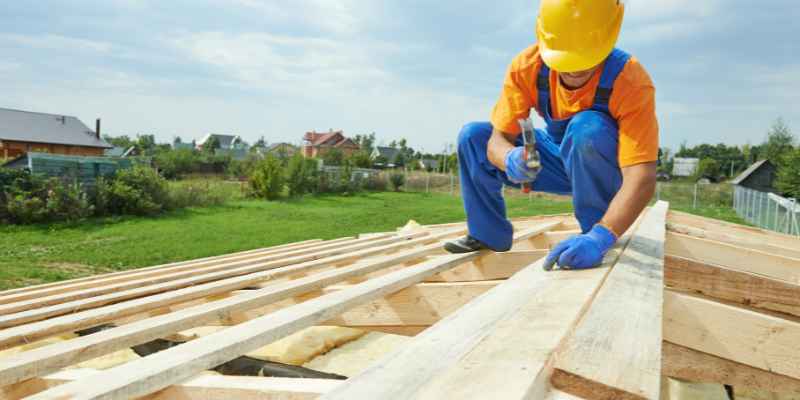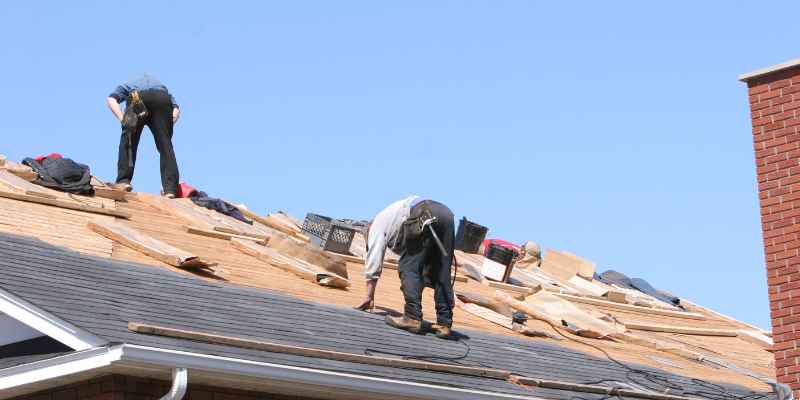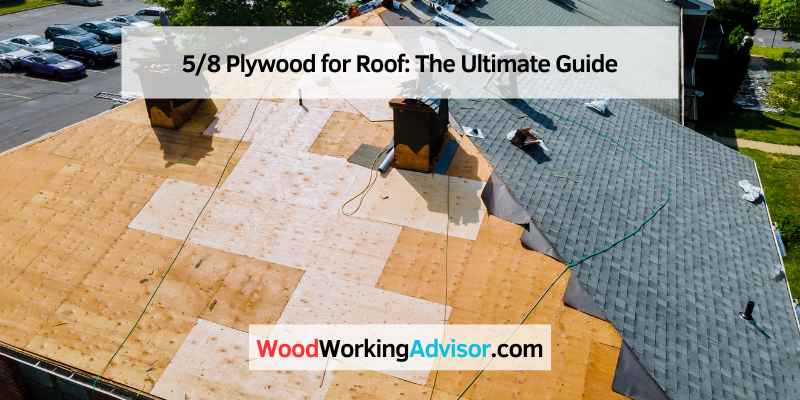For roofing, 5/8 CDX plywood is recommended for its durability and strength. CDX plywood has a C-grade surface on one side and a rougher D-grade surface on the other.
Roofing requires careful planning and the use of the correct materials. When it comes to choosing plywood for a roof, the right size is crucial. Plywood is graded based on its surface grade and intended use. For roofing, 5/8 CDX plywood is the recommended size.
CDX plywood is a popular type of plywood that has a C-grade surface on one side, which is acceptable for use under shingles and roofing felt. The rougher D-grade surface is acceptable on the underside of the plywood sheet. We will discuss more about the type of plywood that is best for roofing and where to purchase it.
Understanding 5/8 Plywood For Roof
5/8 Plywood is a common choice for roofing due to its strength and durability. CDX rated plywood is ideal for structural covering over exterior studding, rafters, or subfloor under an underlayment and represents an ideal balance between price and functionality.
Its C-grade surface is perfect for use under shingles and roofing felt, while the D-grade surface is suitable on the underside of the plywood sheet.
Roofing Plywood: An Overview
When it comes to building a roof, the use of plywood is quite common. Plywood refers to a type of wood sheeting made up of thin layers or “plies” of wood veneer that are glued together. Plywood can be used for a wide range of applications, including roofing. However, not all plywood is created equal. It is important to select the right type of plywood for your roof to ensure its durability and longevity.
5/8 Plywood Strengths And Limitations
One type of plywood that is commonly used for roofing is 5/8 plywood. As the name suggests, this particular type of plywood is 5/8 of an inch thick. 5/8 plywood is known for its strength and durability, making it an ideal choice for roof sheathing. It can also withstand harsh weather conditions such as heavy rain, strong winds, and even hail.
However, despite its strengths, there are some limitations to using 5/8 plywood for roofing. One potential limitation is its weight. 5/8 plywood is heavier compared to thinner plywood sheets, which can make the installation process more difficult. Additionally, it is more expensive compared to thinner plywood sheets.
When selecting 5/8 plywood for your roof, it is important to consider the intended use, climate conditions, and budget. 5/8 plywood may be more suitable for areas that experience severe weather conditions and heavy rainfall. It may also be necessary for larger roofs, where a thicker plywood sheet is needed to provide additional support.
In conclusion, understanding 5/8 plywood for roofing is important to ensure the durability and longevity of your roof. While it may have some limitations, 5/8 plywood remains a popular choice for roof sheathing due to its strength and durability. Consider the factors mentioned above before selecting the right plywood for your roof to ensure its quality and longevity.

Choosing The Right Plywood For Your Roof
Selecting the correct plywood for your roof is crucial. 5/8 plywood for the roof has a C-grade surface that is suitable for use under shingles and roofing felt, while the D-grade surface is preferable for the underside of the plywood sheet.
CDX plywood is best for roof sheathing due to its balance between price and functionality.
When it comes to building a new roof, the type of plywood you choose is essential for the longevity and safety of your structure. With many options available, selecting the right 5/8 plywood for your roofing project can be overwhelming. In this article, we will delve into the key factors you need to consider when choosing the right plywood for your roof, including the type of plywood to use, the grade of the plywood, and any other essential considerations.
What Type Of Plywood Is Best For Roofing?
CDX plywood is the most popular type of plywood used for roofing due to its strength and durability. CDX stands for “C-D Exposure” and refers to the grade of the plywood. The “C” side of the plywood has a rougher texture, with knots and visible splits, while the “D” side is even rougher, with more obvious knots and splits. CDX plywood is bonded with an exterior-grade adhesive, making it resistant to moisture and suitable for use in roofing.
Factors To Consider When Choosing 5/8 Plywood
When choosing 5/8 plywood for your roof, there are several factors you need to consider, including:
- Grade of Plywood: The grade of plywood refers to the quality of the wood used to make it. For roofing, you want a C-D grade plywood that is treated to make it water-resistant.
- Type of Adhesive: Plywood is bonded together using adhesive. For roofing, you should use an exterior-grade adhesive to ensure that it can withstand exposure to moisture and temperature changes.
- Roof Slope: The slope of your roof will determine the minimum thickness of plywood you should use. For a roof with a slope of 4:12 or greater, 5/8 plywood is recommended.
- Span Rating: The span rating refers to the weight capacity of the plywood. For roofs, you should use a span rating of 20 or higher to ensure that the plywood can support the weight of the roofing materials.
- Underlayment: Underlayment is an additional layer of protection that is placed on top of the plywood. For roofs, an asphalt-saturated felt is used to prevent moisture from penetrating the wood.
In conclusion, choosing the right plywood for your roof is crucial for the safety and longevity of your structure. When selecting 5/8 plywood, consider the grade of plywood, the type of adhesive used, roof slope, span rating, and the necessity of underlayment. Choose the right materials, and your roof will withstand the test of time.
Preparing Your Roof For 5/8 Plywood Installation
Ensure proper preparation of your roof before installing 5/8 plywood by checking for and fixing any underlying issues such as leaks, rot, and damage. It is also important to determine the appropriate thickness and grade of plywood required for your roof based on the local building codes and structural load capacity.
Measuring Your Roof For 5/8 Plywood
Measuring your roof correctly is an essential step in ensuring that the plywood you purchase is the right size. Use a measuring tape to measure the length and width of your roof. Multiply the length and the width to get the square footage of your roof. Once you have the square footage of your roof, divide by 32 to determine how many 4′ x 8′ sheets of 5/8 plywood you will need.
Evaluating Your Roof For Repairs
Before you begin your plywood installation, you should evaluate your roof for any repairs that may need to be made. Inspect your roof for any leaks, soft spots, or damage to the decking. Replace any damaged or rotten wood and make any necessary repairs before installing the 5/8 plywood.
It is important to ensure that your roof is in good condition before beginning the installation process, as any underlying issues could potentially damage or compromise the effectiveness of the new plywood installation.
Conclusion
Properly preparing your roof for 5/8 plywood installation is crucial to ensuring that your new roof provides long-lasting protection for your home or building. Measuring your roof correctly and evaluating any potential repairs will help you purchase the right amount of materials, as well as safeguard against any potential damage. Following these steps will help you achieve a successful and stable plywood installation.
Installation Of 5/8 Plywood On Your Roof
Plywood with a thickness of 5/8 is ideal for roof sheathing and can be used for other construction purposes. CDX graded plywood is a good balance between functionality and price, with the “C” side being suitable for use under shingles and roofing felt.
Using this type of plywood can ensure a durable and reliable roofing structure.
Installing 5/8 plywood on your roof can be a daunting task, but with the right tools and materials, it can be done efficiently and correctly. In this article, we will provide a step-by-step guide on how to install 5/8 plywood on your roof. Before we delve into the specifics, let’s take a look at the tools and materials required.
Tools And Materials Required
Before you start installing 5/8 plywood on your roof, ensure you have the following tools and materials:
- 5/8 plywood sheets
- Roofing nails
- Roofing adhesive caulk
- Roofing felt
- Tape measure
- Circular saw
- Nail gun
- Caulking gun
- Roofing hammer
- Safety harness and rope
- Ladder
With all the materials and tools ready, let’s move on to the step-by-step guide to installing 5/8 plywood on your roof.
Step-by-step Guide To Installing 5/8 Plywood On Your Roof
- Preparation: Start by measuring the roof’s square footage, which will help you calculate the plywood size and the number of sheets required.
- Clean the Roof: Remove any debris such as dirt, stones, and old shingles from the roof. Ensure the roof is clean and free of any nails or screws that can puncture the new plywood.
- Install Roofing Felt: Lay roofing felt over the deck, making sure it covers the entire roof surface and overlaps at the edges. Secure the felt using roofing nails or a nail gun.
- Cut Plywood Sheets: Using a circular saw, cut the 5/8 plywood sheets into the required size and shape to fit the roof.
- Install the Plywood Sheets: Place the plywood sheets, ensuring they are perpendicular to the roof rafters. Use roofing adhesive caulk to seal the edges of each sheet, providing a watertight seal. Nail the plywood to the rafters using a nail gun, spacing the nails every 6-8 inches.
- Repeat the Process: Continue adding sheets until the entire roof is covered.
- Inspect the Plywood: Once all the plywood is installed, inspect it to ensure there are no gaps, and the edges are flush with each other.
- Final Inspection: After installation, inspect the new roof for any gaps or misaligned edges. Make any necessary adjustments to ensure the roof’s structure is sturdy and robust enough to withstand weather conditions.
By following these steps, you can install 5/8 plywood on your roof with ease. Remember to prioritize safety and use all the necessary safety equipment, including a safety harness and rope, when working on the roof.
Maintaining Your 5/8 Plywood Roof
Maintaining your 5/8 plywood roof is crucial to keep it in good condition. Regular inspections to check for any damage from weather elements and proper cleaning to remove debris and molds can help prolong the lifespan of your roof. Choosing high-quality plywood and ensuring proper installation can also prevent issues in the long run.
Regular Inspection
Regular inspection is crucial for maintaining the integrity of your 5/8 plywood roof. You should inspect the roof at least twice a year, once in the spring and again in the fall. Make sure to walk around the edges of the roof, carefully inspecting the plywood for any signs of damage or wear. If you find any damage, repair it immediately to prevent further damage.
Cleaning and Repairs
Cleaning your 5/8 plywood roof is important to keep it in good condition. Use a broom, a brush, or a leaf blower to remove any dirt or debris that has accumulated on the roof. Regular cleaning can also help identify any potential issues on the roof.
If you identify any damage on the roof, repairs should be undertaken promptly. Use a roofing nail and hammer to secure loose plywood to the roof structure. Apply roofing adhesive to any loose or cracked plywood seams. Replace any rotten or damaged plywood with a new piece of 5/8 plywood to maintain the structural integrity of the roof.
Maintaining your 5/8 plywood roof is crucial for its longevity and durability. Regular inspection, cleaning, and repairs can prevent major problems down the line. Remember to adhere to proper safety guidelines when inspecting your roof, and always hire a professional for any major repairs.
Costs Of 5/8 Plywood Roofing
5/8 plywood is a popular choice for roofing due to its durability and resistance to moisture. The cost of 5/8 plywood roofing varies depending on the grade, with CDX plywood being a good balance between price and quality. Prices can also vary by supplier.
When it comes to roofing, one of the most crucial decisions you’ll have to make is choosing the right materials. If you’re building a new roof, using 5/8 plywood can be a good choice. This type of plywood is strong and durable, making it an excellent option for withstanding extreme weather conditions. However, before opting for 5/8 plywood, it’s important to consider the costs and how it compares to other roofing materials.
Cost Comparison Of 5/8 Plywood And Other Roofing Materials
While 5/8 plywood is a popular choice for roofing, it’s worth comparing its costs to other roofing materials. Here’s a quick overview of how 5/8 plywood compares to some other common roofing materials:
| Roofing Material | Cost per Sheet |
|---|---|
| 5/8 Plywood | $26.40 – $59.29 |
| Asphalt Shingles | $65 – $200 |
| Metal Roofs | $120 – $900 |
| Tile Roofs | $300 – $500 |
As you can see, 5/8 plywood is a relatively affordable option compared to many other roofing materials. Of course, the overall costs will depend on the size of the roof, labor costs, and other factors. However, if you’re looking for a budget-friendly, yet durable option for your roof, 5/8 plywood could be a great choice.
How To Save Money On 5/8 Plywood Roofing Installation
Even though 5/8 plywood is relatively affordable compared to other options, there are still ways to save money on installation costs. Here are a few tips to help you reduce the costs of using 5/8 plywood for your roofing:
- Shop around for the best prices: Don’t just buy from the first store you come across. Research and compare prices in different stores.
- Choose a reputable installer: Avoid hiring cheap, inexperienced roofers as they can end up costing you more in the long run.
- Order the right amount: To avoid overspending, make sure to measure your roof correctly and order the right amount of 5/8 plywood.
- DIY installation: If you have some roofing experience, you can save a lot of money by installing the 5/8 plywood yourself.
Overall, opting for 5/8 plywood for your roofing needs can be a great choice in terms of affordability and durability. By knowing and comparing the costs of this type of plywood to other materials and following installation tips, you can have a strong and long-lasting roof while sticking to your budget.

Frequently Asked Questions For 5/8 Plywood For Roof
Can You Use 5 8 Plywood For Roof Sheathing?
Yes, 5/8 plywood can be used for roof sheathing. It is ideal for sheathing or structural covering over exterior studding, rafters, or subfloor under an underlayment. CDX plywood represents an ideal balance between price and functionality in terms of roof sheathing.
However, it’s important to carefully consider the project’s structural requirements and local building codes before choosing the roof sheathing material.
How Thick Should Plywood Be For Roofing?
The recommended thickness for plywood used in roofing is 5/8 inches, although it can vary depending on the spacing of the rafters and the weight of the roofing material. CDX plywood with a C-grade surface on the top and a D-grade surface on the bottom is an ideal type of plywood for roof sheathing.
It’s durable and affordable.
Which Plywood Is Best For Roofing?
CDX plywood is ideal for roofing. It represents the perfect balance in terms of price and functionality and is available in C-grade and D-grade surfaces. The C-grade is rougher, with visible knots and splits suitable for use under shingles and roofing felt, while the D-grade is rougher and ideal for the underside of the plywood sheet.
What Is 5 8 Cdx Plywood?
5/8 CDX plywood is a type of plywood that is ideal for sheathing or structural covering over exterior studding, rafters, or subfloor under an underlayment. The CDX stands for C-grade surface on one side and D-grade surface on the other, with an X indicating the kind of glue used to bond the plywood veneers together.
It is a balance between price and functionality and is commonly used for roofing.
Conclusion
To conclude, choosing the right size plywood for a new roof build is crucial for its quality and durability. CDX plywood represents an ideal balance between price and functionality, making it the best choice for roof sheathing. While the “C” side has a more rough surface with visible knots and splits, the “D” side is even rougher with more noticeable knots and splits.
Therefore, 5/8 CDX plywood from reliable suppliers like Schillings and Home Depot can ensure excellent structural covering over exterior studding, rafters, or subfloor under an underlayment.


